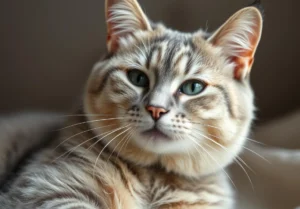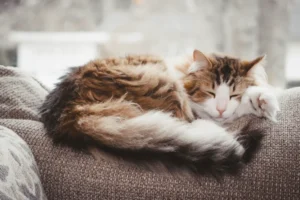Cats are mysterious creatures that always keep us guessing. One of their most intriguing behaviors is the gentle purring sound they make. Have you ever wondered why cats purr? Let’s take a closer look at this fascinating feline phenomenon.
The Anatomy of a Purr
Have you ever wondered how cats produce that mesmerizing purring sound that instantly puts you at ease? Well, let’s dive into the fascinating science behind it. Contrary to popular belief, cats don’t just use their vocal cords to purr. In fact, purring is a complex process that involves the laryngeal muscles and diaphragm working together. When a cat breathes in and out, the laryngeal muscles rapidly open and close the glottis, creating vibrations that result in the purring sound.
While we still have much to learn about the exact mechanisms behind purring, one thing is for sure – it’s a natural and soothing sound that cats use in various situations.
Communication through Purring
Did you know that cats use purring not only to calm themselves but also to communicate with humans and other animals? Yes, you read that right! When your feline friend purrs while sitting on your lap, they are not just showing contentment – they are also bonding with you. It’s their way of expressing affection and trust, creating a deeper connection with you.
Moreover, cats also use purring as a form of communication with other animals. It can signal relaxation, contentment, or even submissiveness. So the next time your cat purrs, pay close attention – they might be trying to tell you something important!
For more in-depth information on cats and their purring behavior, check out this helpful resource from the American Veterinary Medical Association: The Mystery of Cat Purring
Reasons for Purring
Cats purr for various reasons, not just when they’re feeling happy. While contentment is a common trigger for purring, cats also use this soothing sound as a means of self-healing and relaxation. Purring has been linked to lowering stress levels and even promoting bone density. Additionally, mother cats purr to communicate with their kittens, creating a sense of security and comfort. This gentle hum isn’t just a sign of joy; it’s also a tool for maintaining health and fostering relationships.
Purring in Different Situations
Cats adapt their purring based on their circumstances. When a cat is in pain or distress, they may purr as a way to self-soothe and cope with discomfort. This purring can have a slightly different tone, often lower in pitch and more continuous than their usual contented purr. In stressful situations, such as a visit to the vet, a cat might increase their purring to calm themselves down. Understanding the nuances of your cat’s purring can help you decipher their emotional state and provide appropriate care and support.
Additional Insight:
1. Purring during Healing Process: Cats have been known to purr when they are injured or sick. Research suggests that the vibrations created by purring can promote healing in their bones and tissues. So, if your furry friend is purring more than usual, consider it as their natural way of aiding their recovery process.
Remember, decoding your cat’s purring can offer valuable insights into their well-being and emotional state. Pay attention to the context and tone of their purring to better understand their needs and feelings.
Purring Frequencies
Have you ever wondered why cats purr at different frequencies? Well, it turns out that cats produce purring sounds at frequencies between 25 and 150 Hertz. The frequency and intensity of a cat’s purring can vary depending on various factors, such as their emotional state and level of contentment. Interestingly, research has shown that the vibrations produced by purring can have a healing effect on cats, helping to reduce stress and promote relaxation. So, the next time your furry friend starts purring, remember that it’s not just a pleasant sound – it could also be beneficial for their well-being.
Purring in Wild Cats
Did you know that wild cats, like lions and cheetahs, also use purring in their daily lives? While domestic cats primarily purr when they are content, wild cats utilize purring for different purposes. For example, lionesses often purr to communicate with their cubs, signaling that all is well. Cheetahs, on the other hand, use purring as a way to maintain social bonds with their fellow cheetahs. This unique insight into how wild cats use purring sheds light on the versatility of this vocalization across different feline species, highlighting the importance of communication in the animal kingdom.
Additional Unique Insight:
Did you know that domestic cats can also use their purring as a form of self-soothing in stressful situations? In addition to communicating contentment, cats may purr when they are anxious or in pain, as a way to comfort themselves. This dual function of purring showcases the complex nature of this vocalization and its significance in a cat’s emotional expression.
Remember, whether your feline friend is a domestic house cat or a majestic lion in the wild, their purring serves as a vital form of communication and expression.
Fun Facts About Purring
Have you ever wondered why cats make that soothing purring sound? Well, here’s an interesting tidbit for you – cats don’t just purr when they’re happy. They also purr when they’re feeling anxious or even in pain. So, next time your feline friend curls up on your lap and starts purring, it might not always be a sign of contentment.
Now, let’s dive into some fun facts about purring that you may not have known:
- Purring is a form of communication: Cats use purring not only to express their emotions but also to communicate with their human companions. It’s their way of showing affection and seeking comfort.
- It’s a healing mechanism: Believe it or not, the frequency of a cat’s purr falls within a range that has been shown to promote healing and reduce stress. So, that gentle rumble may actually be good for your health!
- Domestic cats are not the only ones who purr: While most people associate purring with domestic cats, other big cats like cheetahs, cougars, and even some species of wild cats also purr. It’s a universal language of comfort and contentment in the feline world.
Next time you hear your cat purring, remember that it’s not just a noise they make when they’re happy – it’s a complex form of communication and a soothing mechanism for them. Interesting, right?
For more in-depth information on the science and mysteries behind purring, check out this informative article from National Geographic: The Science Behind Cat Purring
Alex, a passionate animal lover, has experience in training and understanding animal behavior. As a proud pet parent to two dogs and three cats, he founded AnimalReport.net to share insights from animal experts and expand his knowledge of the animal kingdom.




